Monitoring Discharge in Vegetated Floodplains: A Case Study of the Piave River
Abstract
:1. Introduction
2. Study Area
Characterization of Vegetation in the Field
3. Materials and Methods
3.1. Field Measurement System
3.2. Hydraulic Roughness Estimation
3.2.1. Floodplain Vegetation Roughness
3.2.2. Riverbed Roughness
3.3. Slope-Area Method
- Conveyance of upstream () and downstream () sections are estimated as:where n is the Manning coefficient of the reach under analysis, is the wetted area of the i-th cross-section, and is the hydraulic radius of the i-th cross-section. Hydraulic radius is defined as the ratio between the wetted area and the wetted perimeter.
- Compute the mean conveyance of the slope-area reach (K) as the geometric mean of the conveyance of the upstream and downstream cross-sections, i.e., .
- Estimate a first approximation of the friction slope, S, as:where , i.e., the difference of the water surface elevation measured at the upstream and the downstream cross-sections, and L is the flow length between such sections.
- Estimate a first approximation of discharge, Q, as:
- Compute velocity head at the upstream and downstream cross-sections, , as:where is the velocity-head coefficient, which we consider equal to 1.
- Compute a second approximation of the friction slope, :
- Compute a second approximation of discharge, :
4. Results
4.1. Discharge Estimation
4.2. Field Challenges and Lessons Learned
5. Conclusions
Author Contributions
Funding
Data Availability Statement
Acknowledgments
Conflicts of Interest
References
- Whiting, P.J. Streamflow necessary for environmental maintenance. Annu. Rev. Earth Planet. Sci. 2002, 30, 181–206. [Google Scholar] [CrossRef]
- Pinder, G.F.; Sauer, S.P. Numerical simulation of flood wave modification due to bank storage effects. Water Resour. Res. 1971, 7, 63–70. [Google Scholar] [CrossRef]
- Lammersen, R.; Engel, H.; Van de Langemheen, W.; Buiteveld, H. Impact of river training and retention measures on flood peaks along the Rhine. J. Hydrol. 2002, 267, 115–124. [Google Scholar] [CrossRef]
- Fischer, M. Non-Controlled and Controlled Retention along Rivers. Ph.D. Thesis, Technische Universität München, Munich, Germany, 2008. [Google Scholar]
- Sellin, R.H.J.; Van Beesten, D.P. Conveyance of a managed vegetated two-stage river channel. Proc. Inst. Civ. Eng.-Water Manag. 2004, 157, 21–33. [Google Scholar] [CrossRef]
- Osterkamp, W.R.; Hupp, C.R. Fluvial processes and vegetation—Glimpses of the past, the present, and perhaps the future. Geomorphology 2010, 116, 274–285. [Google Scholar] [CrossRef]
- Uotani, T.; Kanda, K.; Michioku, K. Experimental and numerical study on hydrodynamics of riparian vegetation. J. Hydrodyn. 2014, 26, 796–806. [Google Scholar] [CrossRef]
- Samuels, P.G.; Bramley, M.E.; Evans, E.P. A new conveyance estimation system. In Proceedings of the 37th Annual Conference of River and Coastal Engineers, Keele, UK, July 2002; pp. 1–11. [Google Scholar]
- De Kok, J.L.; Grossmann, M. Large-scale assessment of flood risk and the effects of mitigation measures along the Elbe River. Nat. Hazards 2010, 52, 143–166. [Google Scholar] [CrossRef]
- Sellin, R.H.; Bryant, T.B.; Loveless, J.H. An improved method for roughening floodplains on physical river models. J. Hydraul. Res. 2003, 41, 3–14. [Google Scholar] [CrossRef]
- Habersack, H.; Schober, B.; Hauer, C. Floodplain evaluation matrix (FEM): An interdisciplinary method for evaluating river floodplains in the context of integrated flood risk management. Nat. Hazards 2015, 75, 5–32. [Google Scholar] [CrossRef]
- Rowiński, P.M.; Västilä, K.; Aberle, J.; Järvelä, J.; Kalinowska, M.B. How vegetation can aid in coping with river management challenges: A brief review. Ecohydrol. Hydrobiol. 2018, 18, 345–354. [Google Scholar] [CrossRef]
- D’Ippolito, A.; Calomino, F.; Alfonsi, G.; Lauria, A. Flow resistance in open channel due to vegetation at reach scale: A review. Water 2021, 13, 116. [Google Scholar] [CrossRef]
- Kouwen, N.; Fathi-Moghadam, M. Friction factors for coniferous trees along rivers. J. Hydraul. Eng. 2000, 126, 732–740. [Google Scholar] [CrossRef]
- Järvelä, J. Determination of flow resistance caused by non-submerged woody vegetation. Int. J. River Basin Manag. 2004, 2, 61–70. [Google Scholar] [CrossRef]
- Huthoff, F.; Augustijn, D.C.; Hulscher, S.J. Analytical solution of the depth-averaged flow velocity in case of submerged rigid cylindrical vegetation. Water Resour. Res. 2007, 43. [Google Scholar] [CrossRef]
- Baptist, M.J.; Babovic, V.; Rodríguez Uthurburu, J.; Keijzer, M.; Uittenbogaard, R.E.; Mynett, A.; Verwey, A. On inducing equations for vegetation resistance. J. Hydraul. Res. 2007, 45, 435–450. [Google Scholar] [CrossRef]
- Luhar, M.; Nepf, H.M. From the blade scale to the reach scale: A characterization of aquatic vegetative drag. Adv. Water Resour. 2013, 51, 305–316. [Google Scholar] [CrossRef]
- Nepf, H.M. Hydrodynamics of vegetated channels. J. Hydraul. Res. 2012, 50, 262–279. [Google Scholar] [CrossRef]
- Aberle, J.; Järvelä, J. Flow resistance of emergent rigid and flexible floodplain vegetation. J. Hydraul. Res. 2013, 51, 33–45. [Google Scholar] [CrossRef]
- Vargas-Luna, A.; Crosato, A.; Uijttewaal, W.S. Effects of vegetation on flow and sediment transport: Comparative analyses and validation of predicting models. Earth Surf. Process. Landforms 2013, 40, 157–176. [Google Scholar] [CrossRef]
- Huthoff, F. Modeling Hydraulic Resistance of Floodplain Vegetation. Ph.D. Thesis, University of Twente, Twente, The Netherlands, 2007. [Google Scholar]
- Straatsma, M.W. Quantitative mapping of hydrodynamic vegetation density of floodplain forests under leaf-off conditions using airborne laser scanning. Photogramm. Eng. Remote Sens. 2008, 74, 987–998. [Google Scholar] [CrossRef]
- Antonarakis, A.S.; Richards, K.S.; Brasington, J.; Muller, E. Determining leaf area index and leafy tree roughness using terrestrial laser scanning. Water Resour. Res. 2010, 46. [Google Scholar] [CrossRef]
- Forzieri, G.; Degetto, M.; Righetti, M.; Castelli, F.; Preti, F. Satellite multispectral data for improved floodplain roughness modelling. J. Hydrol. 2011, 407, 41–57. [Google Scholar] [CrossRef]
- Forzieri, G.; Castelli, F.; Preti, F. Advances in remote sensing of hydraulic roughness. Int. J. Remote Sens. 2012, 33, 630–654. [Google Scholar] [CrossRef]
- Prior, E.M.; Aquilina, C.A.; Czuba, J.A.; Pingel, T.J.; Hession, W.C. Estimating Floodplain Vegetative Roughness Using Drone-Based Laser Scanning and Structure from Motion Photogrammetry. Remote Sens. 2021, 13, 2616. [Google Scholar] [CrossRef]
- Barnes, H.H. Roughness Characteristics of Natural Channels; US Government Printing Office: Washington, DC, USA, 1967.
- Arcement, G.J.; Schneider, V.R. Guide for Selecting Manning’s Roughness Coefficients for Natural Channels and Flood Plains; US Government Printing Office: Washington, DC, USA, 1989.
- Chow, V.T. Open-Channel Hydraulics; McGraw-Hill Book Company: New York, NY, USA, 1959; pp. 154–196. [Google Scholar]
- Khatibi, R.H.; Williams, J.J.; Wormleaton, P.R. Identification problem of open-channel friction parameters. J. Hydraul. Eng. 1997, 123, 1078–1088. [Google Scholar] [CrossRef]
- Dalrymple, T.; Benson, M.A. Measurement of Peak Discharge by the Slope-Area Method; US Government Printing Office: Washington, DC, USA, 1967; pp. 1–12.
- Muste, M.; Hoitink, T. Measuring flood discharge. In Oxford Research Encyclopedia of Natural Hazard Science; Oxford University Press: Oxford, UK, 2017. [Google Scholar]
- Jarrett, R.D. Errors in slope-area computations of peak discharges in mountain streams. J. Hydrol. 1987, 96, 53–67. [Google Scholar] [CrossRef]
- Muste, M.; Bacotiu, C.; Thomas, D. Evaluation of the slope-area method for continuous streamflow monitoring. In Proceedings of the 38th IAHR World Congress, Panama City, Panama, 1–6 September 2019; pp. 121–130. [Google Scholar]
- Smith, C.F.; Cordova, J.T.; Wiele, S.M. The Continuous Slope-Area Method for Computing Event Hydrographs; U.S Geological Survey Scientific Investigations Report 2010-5241; U.S. Department of the Interior; U.S. Geological Survey: Reston, VA, USA, 2010.
- Costa, J.E.; Cheng, R.T.; Haeni, F.P.; Melcher, N.; Spicer, K.R.; Hayes, E.; Plant, W.; Hayes, K.; Teague, C.; Barrick, D. Use of radars to monitor stream discharge by noncontact methods. Water Resour. Res. 2006, 42. [Google Scholar] [CrossRef]
- Mueller, D.S.; Wagner, C.R. Measuring Discharge with Acoustic Doppler Current Profilers from a Moving Boat; U.S Geological Survey Techniques and Methods 3A-22; U.S. Geological Survey: Reston, VA, USA, 2009.
- Le Boursicaud, R.; Pénard, L.; Hauet, A.; Thollet, F.; Le Coz, J. Gauging extreme floods on YouTube: Application of LSPIV to home movies for the post-event determination of stream discharges. Hydrol. Process. 2016, 30, 90–105. [Google Scholar] [CrossRef]
- Warren, J.D.; Peterson, B.J. Use of a 600-kHz Acoustic Doppler Current Profiler to measure estuarine bottom type, relative abundance of submerged aquatic vegetation, and eelgrass canopy height. Estuar. Coast. Shelf Sci. 2007, 72, 53–62. [Google Scholar] [CrossRef]
- Bjerklie, D.M.; Moller, D.; Smith, L.C.; Dingman, S.L. Estimating discharge in rivers using remotely sensed hydraulic information. J. Hydrol. 2005, 309, 191–209. [Google Scholar] [CrossRef]
- Temimi, M.; Leconte, R.; Brissette, F.; Chaouch, N. Flood monitoring over the Mackenzie River Basin using passive microwave data. Remote Sens. Environ. 2005, 98, 344–355. [Google Scholar] [CrossRef]
- Tarpanelli, A.; Camici, S.; Nielsen, K.; Brocca, L.; Moramarco, T.; Benveniste, J. Potentials and limitations of Sentinel-3 for river discharge assessment. Adv. Space Res. 2021, 68, 593–606. [Google Scholar] [CrossRef]
- Abdalla, S.; Kolahchi, A.A.; Ablain, M.; Adusumilli, S.; Bhowmick, S.A.; Alou-Font, E.; Amarouche, L.; Andersen, O.B.; Antich, H.; Aouf, L.; et al. Altimetry for the future: Building on 25 years of progress. Adv. Space Res. 2021, 68, 319–363. [Google Scholar] [CrossRef]
- Bogning, S.; Frappart, F.; Blarel, F.; Niño, F.; Mahé, G.; Bricquet, J.-P.; Seyler, F.; Onguéné, R.; Etamé, J.; Paiz, M.-C.; et al. Monitoring water levels and discharges using radar altimetry in an ungauged river basin: The case of the Ogooué. Remote Sens. 2018, 10, 350. [Google Scholar] [CrossRef]
- Tarpanelli, A.; Brocca, L.; Lacava, T.; Melone, F.; Moramarco, T.; Faruolo, M.; Pergola, N.; Tramutoli, V. Toward the estimation of river discharge variations using MODIS data in ungauged basins. Remote Sens. Environ. 2013, 136, 47–55. [Google Scholar] [CrossRef]
- Hou, J.; Van Dijk, A.I.; Renzullo, L.J.; Vertessy, R.A. Using modelled discharge to develop satellite-based river gauging: A case study for the Amazon Basin. Hydrol. Earth Syst. Sci. 2018, 22, 6435–6448. [Google Scholar] [CrossRef]
- Gehring, J.; Duvvuri, B.; Beighley, E. Deriving River Discharge Using Remotely Sensed Water Surface Characteristics and Satellite Altimetry in the Mississippi River Basin. Remote Sens. 2022, 14, 3541. [Google Scholar] [CrossRef]
- Samboko, H.T.; Abas, I.; Luxemburg, W.M.J.; Savenije, H.H.G.; Makurira, H.; Banda, K.; Winsemius, H.C. Evaluation and improvement of remote sensing-based methods for river flow management. Phys. Chem. Earth Parts A/B/C 2020, 117. [Google Scholar] [CrossRef]
- Autorità di Bacino dei Fiumi Isonzo, Tagliamento, Livenza, Piave, Brenta-Bacchiglione. Piano Stralcio per la Sicurezza Idraulica del Medio e Basso Corso del Fiume Piave. 2010. Available online: https://www.comune.sernaglia.tv.it/c026080/zf/index.php/servizi-aggiuntivi/index/index/idtesto/181 (accessed on 20 September 2023).
- Balasso, F. Effects of Some Interventions to Mitigate the Hydraulics Risk in the Upper Course of Piave River. Master’s Thesis, University of Padua, Padua, Italy, 2017. [Google Scholar]
- Botter, G.; Basso, S.; Porporato, A.; Rodriguez-Iturbe, I.; Rinaldo, A. Natural streamflow regime alterations: Damming of the Piave river basin (Italy). Water Resour. Res. 2010, 46. [Google Scholar] [CrossRef]
- Lacroix Sofrel. Available online: https://www.lacroix-environment.com/offer (accessed on 1 August 2023).
- North Surveying. Available online: https://gnssrtk.com/index.php/instruments/gnss-rtk-triple-frequency-receivers (accessed on 1 August 2023).
- Augustijn, D.C.; Huthoff, F.; Van Velzen, E.H. Comparison of vegetation roughness descriptions. In Proceedings of the River Flow, Çeşme, Izmir, Turkey, 3–5 September 2008; pp. 343–350. [Google Scholar]
- Gerlinger, K.; Scherer, U. Simulating Soil Erosion and Phosphorus Transport on Loess Soils Using Advanced Hydrological and Erosional Models; IAHS Publication: Vienna, Austria, 1998; pp. 119–128. [Google Scholar]
- Yen, B.C. Open channel flow resistance. J. Hydraul. Eng. 2002, 128, 20–39. [Google Scholar] [CrossRef]
- PARIO Automated Soil Particle Size Analysis. Available online: https://www.metergroup.com/en/meter-environment/products/pario-soil-texture-particle-size-analysis (accessed on 1 August 2023).
- HEC-RAS Software. Available online: https://www.hec.usace.army.mil/software/hec-ras/ (accessed on 3 August 2023).
- Sontek. RiverSurveyor S5/M9 System Manual; SonTek: San Diego, CA, USA, 2016. [Google Scholar]
- ARPAV. Hydrometric Station Data at Ponte di Piave. Available online: https://www.arpa.veneto.it/dati-ambientali/dati-in-diretta/meteo-idro-nivo/variabili_idro?codseqst=300001769&focus=LIVIDRO (accessed on 3 August 2023).
- Benson, M.A.; Dalrymple, T. General Field and Office Procedures for Indirect Discharge Measurements; US Government Printing Office: Washington, DC, USA, 1967; No. 03-A1.
- Ghani, A.A.; Zakaria, N.A.; Kiat, C.C.; Ariffin, J.; Hasan, Z.A.; Abdul Ghaffar, A.B. Revised equations for Manning’s coefficient for Sand-Bed Rivers. Int. J. River Basin Manag. 2007, 5, 329–346. [Google Scholar] [CrossRef]
- Stewart, A.M.; Callegary, J.B.; Smith, C.F.; Gupta, H.V.; Leenhouts, J.M.; Fritzinger, R.A. Use of the continuous slope-area method to estimate runoff in a network of ephemeral channels, southeast Arizona, USA. J. Hydrol. 2012, 472, 148–158. [Google Scholar] [CrossRef]
- ARPAV. Bolletino Risorsa Idrica n.328. 2020. Available online: https://www.arpa.veneto.it/temi-ambientali/idrologia/file-e-allegati/bollettini-risorsa-idrica/2020 (accessed on 20 September 2023).
- Regione del Veneto. Relazione Evento 04-09/12/2020—Parte pluviometrica, 04-12/12/2020—Analisi Idrologica. 2020. Available online: https://www.regione.veneto.it/documents/90748/4045165/Relazione_201204_12_U_rev01.pdf/7a654e6d-35bc-49cf-89b7-e7421b30b458 (accessed on 20 September 2023).
- Monitoring Piave River. Available online: https://www.pontedipiave.com/webcam/ (accessed on 15 September 2021).
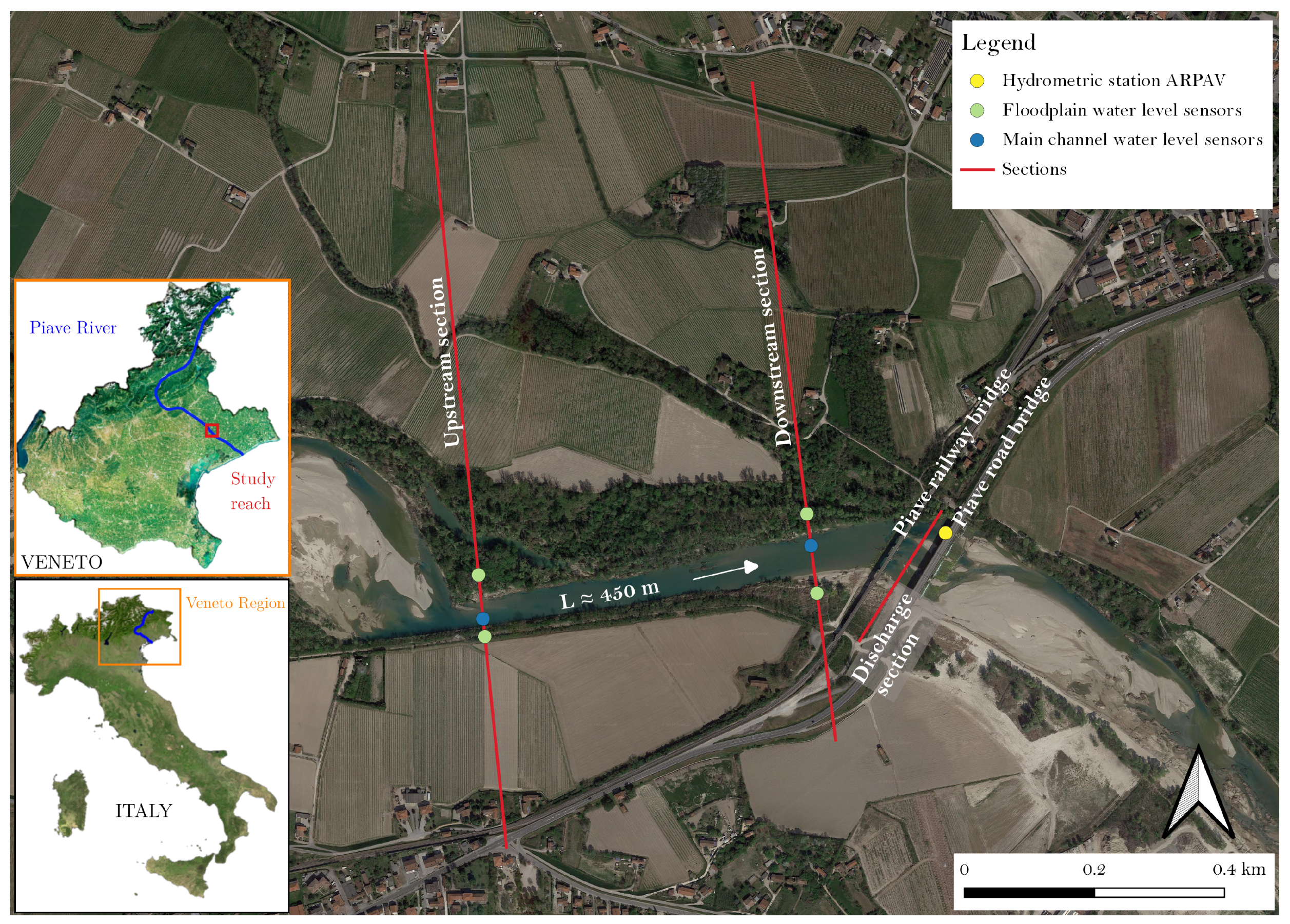

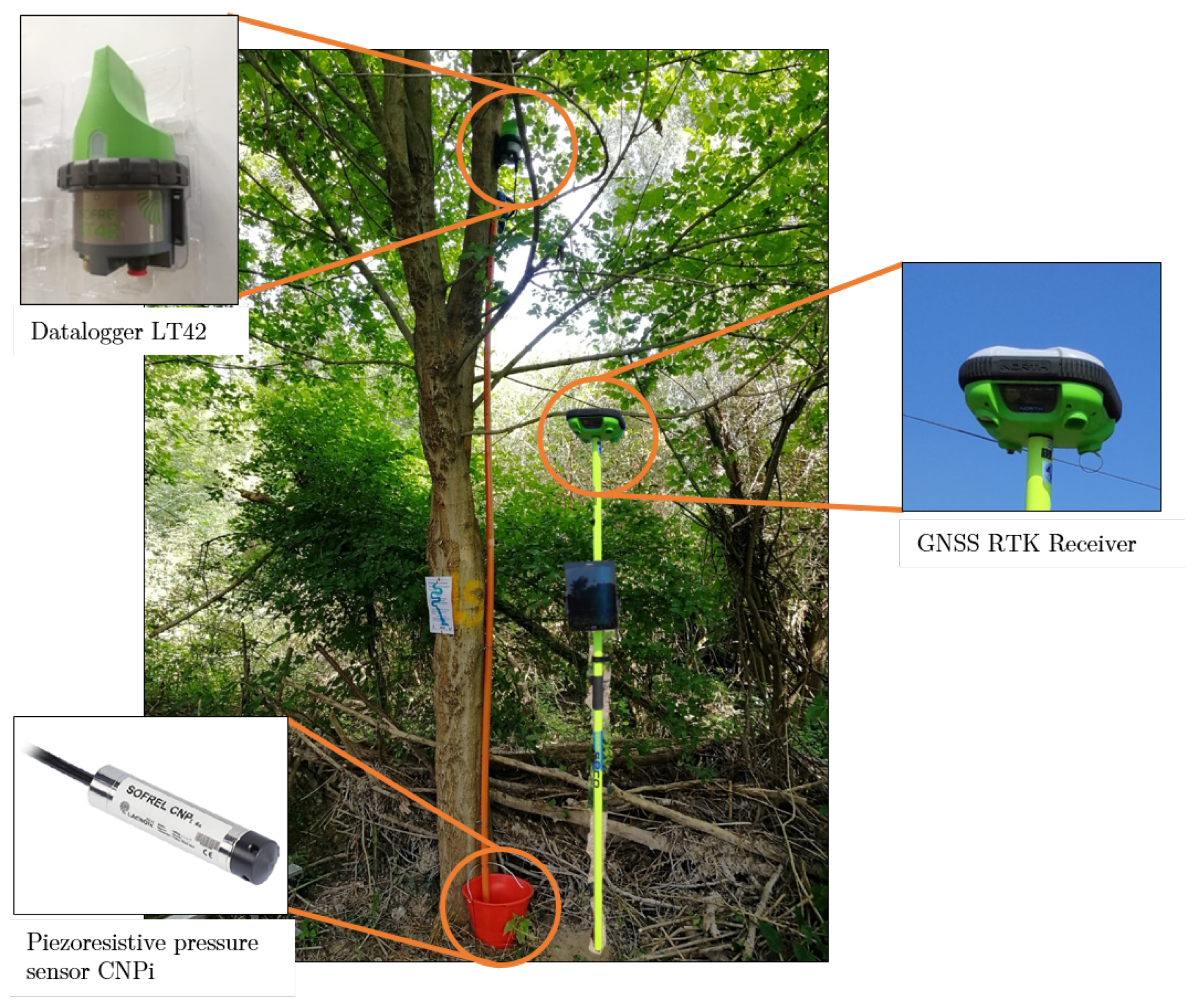
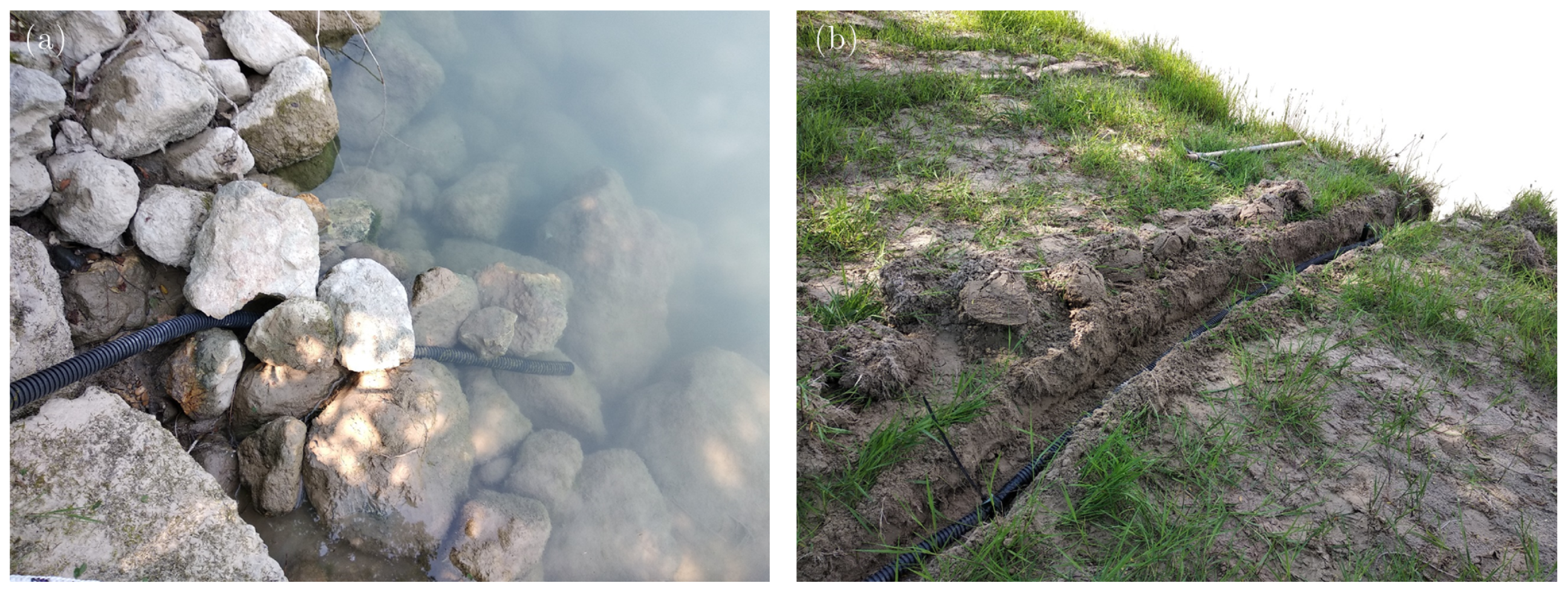
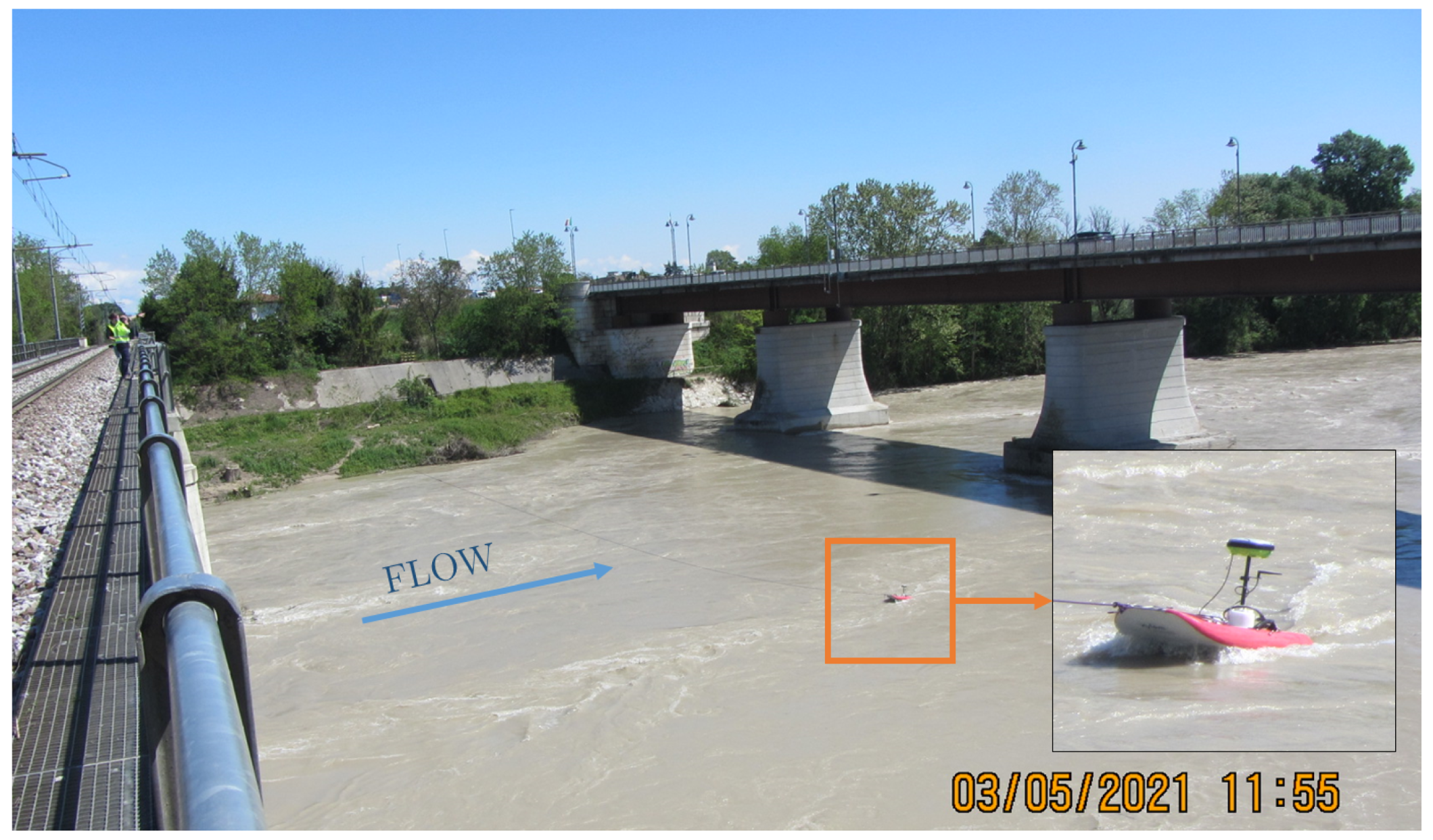


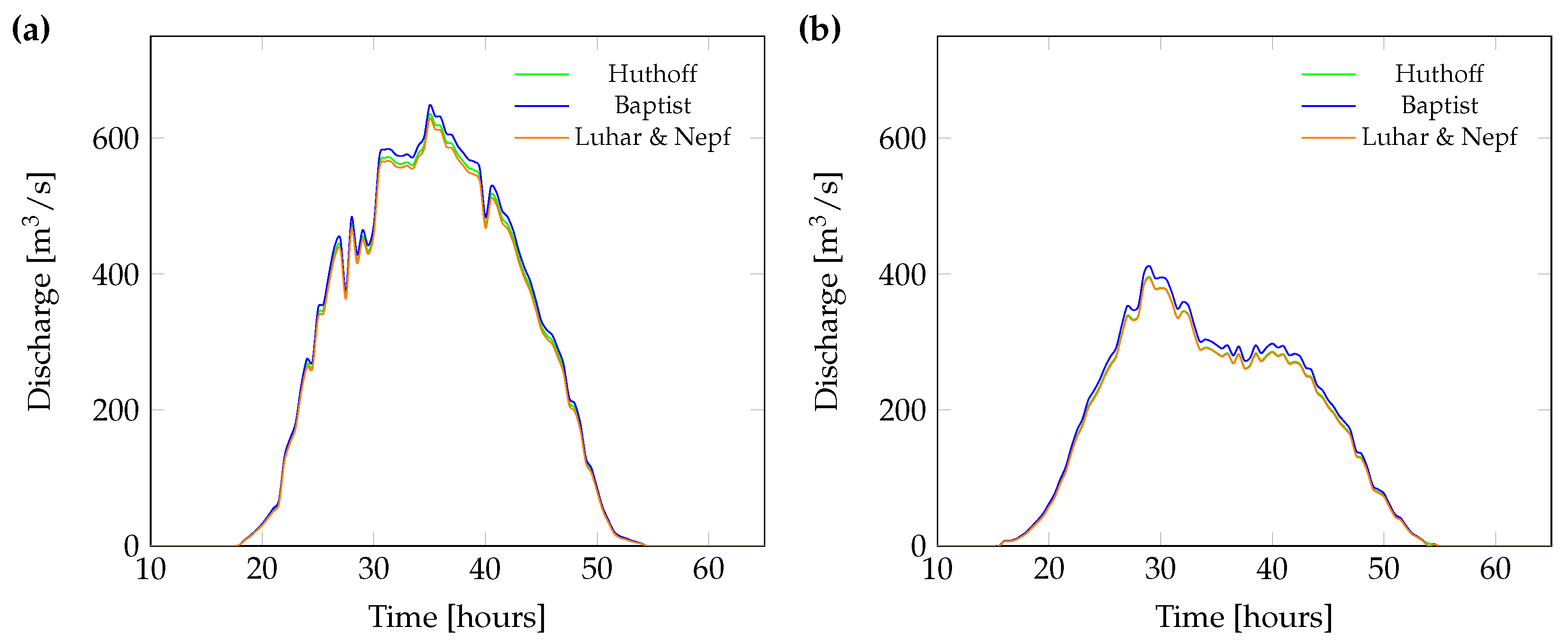
| Transect | Q [m/s] | B [m] | V [m/s] | A [m2] | WSE [m.a.s.l] | WSE ARPAV 1 [m.a.s.l] |
|---|---|---|---|---|---|---|
| 1 | 255.17 | 127.13 | 1.17 | 217.81 | 3.72 | 3.62 |
| 2 | 261.45 | 131.78 | 1.65 | 158.69 | 3.74 | 3.59 |
| 3 | 261.24 | 126.39 | 1.30 | 200.86 | 3.73 | 3.59 |
| 4 | 259.43 | 125.62 | 1.68 | 154.06 | 3.73 | 3.59 |
| 5 | 254.28 | 123.50 | 1.39 | 183.27 | 3.73 | 3.59 |
| 6 | 257.03 | 128.63 | 1.68 | 153.32 | 3.74 | 3.59 |
| Average | 258.10 | 127.18 | 1.48 | 178 | 3.73 | 3.60 |
Disclaimer/Publisher’s Note: The statements, opinions and data contained in all publications are solely those of the individual author(s) and contributor(s) and not of MDPI and/or the editor(s). MDPI and/or the editor(s) disclaim responsibility for any injury to people or property resulting from any ideas, methods, instructions or products referred to in the content. |
© 2023 by the authors. Licensee MDPI, Basel, Switzerland. This article is an open access article distributed under the terms and conditions of the Creative Commons Attribution (CC BY) license (https://creativecommons.org/licenses/by/4.0/).
Share and Cite
Herrera Gómez, V.; Ravazzani, G.; Mancini, M.; Marchi, N.; Lingua, E.; Ferri, M. Monitoring Discharge in Vegetated Floodplains: A Case Study of the Piave River. Water 2023, 15, 3470. https://doi.org/10.3390/w15193470
Herrera Gómez V, Ravazzani G, Mancini M, Marchi N, Lingua E, Ferri M. Monitoring Discharge in Vegetated Floodplains: A Case Study of the Piave River. Water. 2023; 15(19):3470. https://doi.org/10.3390/w15193470
Chicago/Turabian StyleHerrera Gómez, Verónica, Giovanni Ravazzani, Marco Mancini, Niccolò Marchi, Emanuele Lingua, and Michele Ferri. 2023. "Monitoring Discharge in Vegetated Floodplains: A Case Study of the Piave River" Water 15, no. 19: 3470. https://doi.org/10.3390/w15193470
APA StyleHerrera Gómez, V., Ravazzani, G., Mancini, M., Marchi, N., Lingua, E., & Ferri, M. (2023). Monitoring Discharge in Vegetated Floodplains: A Case Study of the Piave River. Water, 15(19), 3470. https://doi.org/10.3390/w15193470







